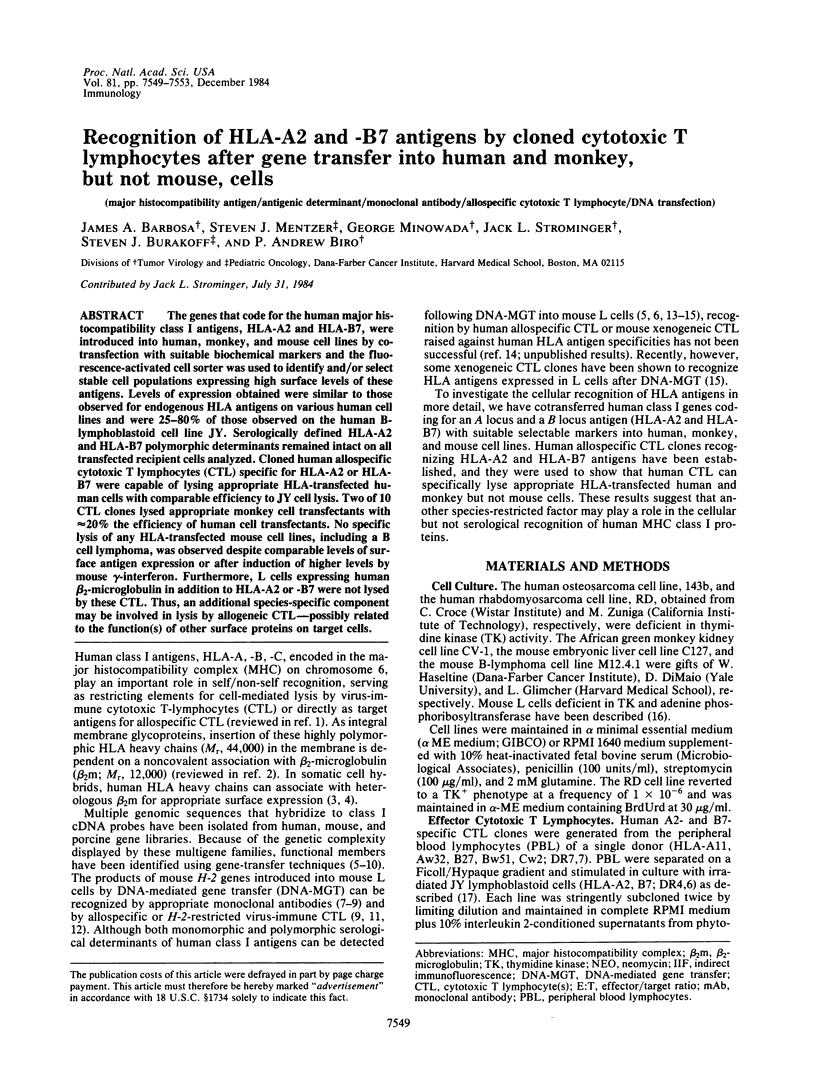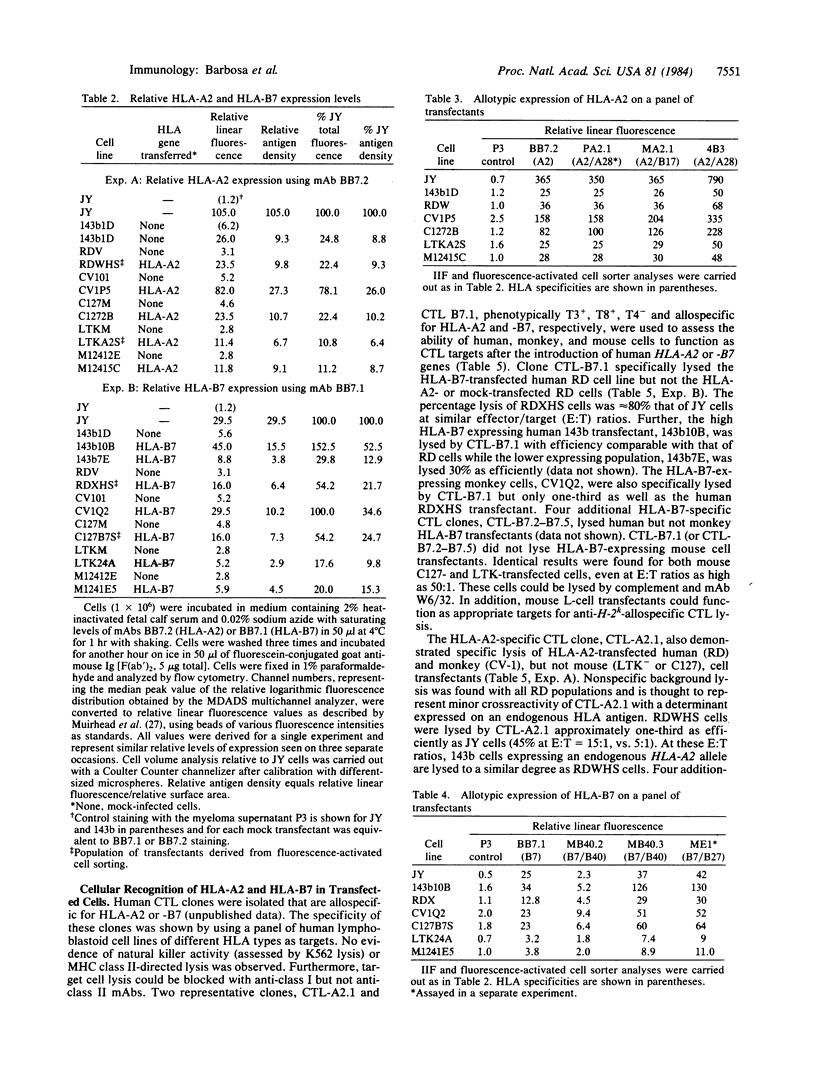Abstract
The genes that code for the human major histocompatibility class I antigens, HLA-A2 and HLA-B7, were introduced into human, monkey, and mouse cell lines by cotransfection with suitable biochemical markers and the fluorescence-activated cell sorter was used to identify and/or select stable cell populations expressing high surface levels of these antigens. Levels of expression obtained were similar to those observed for endogenous HLA antigens on various human cell lines and were 25-80% of those observed on the human B-lymphoblastoid cell line JY. Serologically defined HLA-A2 and HLA-B7 polymorphic determinants remained intact on all transfected recipient cells analyzed. Cloned human allospecific cytotoxic T lymphocytes (CTL) specific for HLA-A2 or HLA-B7 were capable of lysing appropriate HLA-transfected human cells with comparable efficiency to JY cell lysis. Two of 10 CTL clones lysed appropriate monkey cell transfectants with approximately equal to 20% the efficiency of human cell transfectants. No specific lysis of any HLA-transfected mouse cell lines, including a B cell lymphoma, was observed despite comparable levels of surface antigen expression or after induction of higher levels by mouse gamma-interferon. Furthermore, L cells expressing human beta 2-microglobulin in addition to HLA-A2 or -B7 were not lysed by these CTL. Thus, an additional species-specific component may be involved in lysis by allogeneic CTL--possibly related to the function(s) of other surface proteins on target cells.
Full text
PDF




Selected References
These references are in PubMed. This may not be the complete list of references from this article.
- Arce-Gomez B., Jones E. A., Barnstable C. J., Solomon E., Bodmer W. F. The genetic control of HLA-A and B antigens in somatic cell hybrids: requirement for beta2 microglobulin. Tissue Antigens. 1978 Feb;11(2):96–112. doi: 10.1111/j.1399-0039.1978.tb01233.x. [DOI] [PubMed] [Google Scholar]
- Barbosa J. A., Kamarck M. E., Biro P. A., Weissman S. M., Ruddle F. H. Identification of human genomic clones coding the major histocompatibility antigens HLA-a2 and HLA-B7 by DNA-mediated gene transfer. Proc Natl Acad Sci U S A. 1982 Oct;79(20):6327–6331. doi: 10.1073/pnas.79.20.6327. [DOI] [PMC free article] [PubMed] [Google Scholar]
- Barnstable C. J., Bodmer W. F., Brown G., Galfre G., Milstein C., Williams A. F., Ziegler A. Production of monoclonal antibodies to group A erythrocytes, HLA and other human cell surface antigens-new tools for genetic analysis. Cell. 1978 May;14(1):9–20. doi: 10.1016/0092-8674(78)90296-9. [DOI] [PubMed] [Google Scholar]
- Bernabeu C., Finlay D., van de Rijn M., Maziarz R. T., Biro P. A., Spits H., de Vries J., Terhorst C. P. Expression of the major histocompatibility antigens HLA-A2 and HLA-B7 by DNA-mediated gene transfer. J Immunol. 1983 Oct;131(4):2032–2037. [PubMed] [Google Scholar]
- Bernabeu C., van de Rijn M., Lerch P. G., Terhorst C. P. Beta 2-microglobulin from serum associates with MHC class I antigens on the surface of cultured cells. Nature. 1984 Apr 12;308(5960):642–645. doi: 10.1038/308642a0. [DOI] [PubMed] [Google Scholar]
- Brodsky F. M., Parham P., Barnstable C. J., Crumpton M. J., Bodmer W. F. Monoclonal antibodies for analysis of the HLA system. Immunol Rev. 1979;47:3–61. doi: 10.1111/j.1600-065x.1979.tb00288.x. [DOI] [PubMed] [Google Scholar]
- Dausset J. The major histocompatibility complex in man. Science. 1981 Sep 25;213(4515):1469–1474. doi: 10.1126/science.6792704. [DOI] [PubMed] [Google Scholar]
- Ellis S. A., Taylor C., McMichael A. Recognition of HLA-B27 and related antigen by a monoclonal antibody. Hum Immunol. 1982 Aug;5(1):49–59. doi: 10.1016/0198-8859(82)90030-1. [DOI] [PubMed] [Google Scholar]
- Enquist L. W., Vande Woude G. F., Wagner M., Smiley J. R., Summers W. C. Construction and characterization of a recombinant plasmid encoding the gene for the thymidine kinase of Herpes simplex type 1 virus. Gene. 1979 Nov;7(3-4):335–342. doi: 10.1016/0378-1119(79)90052-0. [DOI] [PubMed] [Google Scholar]
- Goodenow R. S., McMillan M., Nicolson M., Sher B. T., Eakle K., Davidson N., Hood L. Identification of the class I genes of the mouse major histocompatibility complex by DNA-mediated gene transfer. Nature. 1982 Nov 18;300(5889):231–237. doi: 10.1038/300231a0. [DOI] [PubMed] [Google Scholar]
- Herman A., Parham P., Weissman S. M., Engelhard V. H. Recognition by xenogeneic cytotoxic T lymphocytes of cells expressing HLA-A2 or HLA-B7 after DNA-mediated gene transfer. Proc Natl Acad Sci U S A. 1983 Aug;80(16):5056–5060. doi: 10.1073/pnas.80.16.5056. [DOI] [PMC free article] [PubMed] [Google Scholar]
- Kamarck M. E., Barbosa J. A., Ruddle F. H. Somatic cell genetic analysis of HLA-A, B, C and human beta 2-microglobulin expression. Somatic Cell Genet. 1982 May;8(3):385–402. doi: 10.1007/BF01538895. [DOI] [PubMed] [Google Scholar]
- Kavathas P., Herzenberg L. A. Stable transformation of mouse L cells for human membrane T-cell differentiation antigens, HLA and beta 2-microglobulin: selection by fluorescence-activated cell sorting. Proc Natl Acad Sci U S A. 1983 Jan;80(2):524–528. doi: 10.1073/pnas.80.2.524. [DOI] [PMC free article] [PubMed] [Google Scholar]
- Krensky A. M., Reiss C. S., Mier J. W., Strominger J. L., Burakoff S. J. Long-term human cytolytic T-cell lines allospecific for HLA-DR6 antigen are OKT4+. Proc Natl Acad Sci U S A. 1982 Apr;79(7):2365–2369. doi: 10.1073/pnas.79.7.2365. [DOI] [PMC free article] [PubMed] [Google Scholar]
- Krensky A. M., Sanchez-Madrid F., Robbins E., Nagy J. A., Springer T. A., Burakoff S. J. The functional significance, distribution, and structure of LFA-1, LFA-2, and LFA-3: cell surface antigens associated with CTL-target interactions. J Immunol. 1983 Aug;131(2):611–616. [PubMed] [Google Scholar]
- Lemonnier F. A., Le Bouteiller P. P., Malissen B., Golstein P., Malissen M., Mishal Z., Caillol D. H., Jordan B. R., Kourilsky F. M. Transformation of murine LMTK- cells with purified HLA class I genes. I. Modification of conformation of murine beta 2-microglobulin upon its association with HLA heavy chains. J Immunol. 1983 Mar;130(3):1432–1438. [PubMed] [Google Scholar]
- Lemonnier F. A., Malissen M., Golstein P., Le Bouteiller P., Rebai N., Damotte M., Birnbaum D., Caillol D., Trucy J., Jordan B. R. Expression of human class I histocompatibility antigens at the surface of DNA-transformed mouse L cells. Immunogenetics. 1982;16(4):355–361. doi: 10.1007/BF00372307. [DOI] [PubMed] [Google Scholar]
- Margulies D. H., Evans G. A., Ozato K., Camerini-Otero R. D., Tanaka K., Appella E., Seidman J. G. Expression of H-2Dd and H-2Ld mouse major histocompatibility antigen genes in L cells after DNA-mediated gene transfer. J Immunol. 1983 Jan;130(1):463–470. [PubMed] [Google Scholar]
- Martz E. Mechanism of specific tumor-cell lysis by alloimmune T lymphocytes: resolution and characterization of discrete steps in the cellular interaction. Contemp Top Immunobiol. 1977;7:301–361. doi: 10.1007/978-1-4684-3054-7_9. [DOI] [PubMed] [Google Scholar]
- McCune J. M., Humphreys R. E., Yocum R. R., Strominger J. L. Enhanced representation of HL-A antigens on human lymphocytes after mitogenesis induced by phytohemagglutinin or Epstein-Barr virus. Proc Natl Acad Sci U S A. 1975 Aug;72(8):3206–3209. doi: 10.1073/pnas.72.8.3206. [DOI] [PMC free article] [PubMed] [Google Scholar]
- McMichael A. J., Parham P., Rust N., Brodsky F. A monoclonal antibody that recognizes an antigenic determinant shared by HLA A2 and B17. Hum Immunol. 1980 Sep;1(2):121–129. doi: 10.1016/0198-8859(80)90099-3. [DOI] [PubMed] [Google Scholar]
- Mellor A. L., Golden L., Weiss E., Bullman H., Hurst J., Simpson E., James R. F., Townsend A. R., Taylor P. M., Schmidt W. Expression of murine H-2Kb histocompatibility antigen in cells transformed with cloned H-2 genes. Nature. 1982 Aug 5;298(5874):529–534. doi: 10.1038/298529a0. [DOI] [PubMed] [Google Scholar]
- Muirhead K. A., Schmitt T. C., Muirhead A. R. Determination of linear fluorescence intensities from flow cytometric data accumulated with logarithmic amplifiers. Cytometry. 1983 Jan;3(4):251–256. doi: 10.1002/cyto.990030404. [DOI] [PubMed] [Google Scholar]
- Oi V. T., Morrison S. L., Herzenberg L. A., Berg P. Immunoglobulin gene expression in transformed lymphoid cells. Proc Natl Acad Sci U S A. 1983 Feb;80(3):825–829. doi: 10.1073/pnas.80.3.825. [DOI] [PMC free article] [PubMed] [Google Scholar]
- Orn A., Goodenow R. S., Hood L., Brayton P. R., Woodward J. G., Harmon R. C., Frelinger J. A. Product of a transferred H-2Ld gene acts as restriction element for LCMV-specific killer T cells. Nature. 1982 Jun 3;297(5865):415–417. doi: 10.1038/297415a0. [DOI] [PubMed] [Google Scholar]
- Parham P. Monoclonal antibodies against two separate alloantigenic sites of HLA-B40. Immunogenetics. 1981;13(6):509–527. doi: 10.1007/BF00343719. [DOI] [PubMed] [Google Scholar]
- Ploegh H. L., Orr H. T., Strominger J. L. Major histocompatibility antigens: the human (HLA-A, -B, -C) and murine (H-2K, H-2D) class I molecules. Cell. 1981 May;24(2):287–299. doi: 10.1016/0092-8674(81)90318-4. [DOI] [PubMed] [Google Scholar]
- Reiss C. S., Evans G. A., Margulies D. H., Seidman J. G., Burakoff S. J. Allospecific and virus-specific cytolytic T lymphocytes are restricted to the N or C1 domain of H-2 antigens expressed on L cells after DNA-mediated gene transfer. Proc Natl Acad Sci U S A. 1983 May;80(9):2709–2712. doi: 10.1073/pnas.80.9.2709. [DOI] [PMC free article] [PubMed] [Google Scholar]
- Singer D. S., Camerini-Otero R. D., Satz M. L., Osborne B., Sachs D., Rudikoff S. Characterization of a porcine genomic clone encoding a major histocompatibility antigen: expression in mouse L cells. Proc Natl Acad Sci U S A. 1982 Mar;79(5):1403–1407. doi: 10.1073/pnas.79.5.1403. [DOI] [PMC free article] [PubMed] [Google Scholar]
- Southern P. J., Berg P. Transformation of mammalian cells to antibiotic resistance with a bacterial gene under control of the SV40 early region promoter. J Mol Appl Genet. 1982;1(4):327–341. [PubMed] [Google Scholar]
- Wallach D., Fellous M., Revel M. Preferential effect of gamma interferon on the synthesis of HLA antigens and their mRNAs in human cells. Nature. 1982 Oct 28;299(5886):833–836. doi: 10.1038/299833a0. [DOI] [PubMed] [Google Scholar]
- Ways J. P., Parham P. The antigenic structure of HLA-A2: an analysis with competitive binding assays and monoclonal antibodies. J Immunol. 1983 Aug;131(2):856–863. [PubMed] [Google Scholar]
- Wigler M., Silverstein S., Lee L. S., Pellicer A., Cheng Y. c., Axel R. Transfer of purified herpes virus thymidine kinase gene to cultured mouse cells. Cell. 1977 May;11(1):223–232. doi: 10.1016/0092-8674(77)90333-6. [DOI] [PubMed] [Google Scholar]
- Yang S. Y., Morishima Y., Collins N. H., Alton T., Pollack M. S., Yunis E. J., Dupont B. Comparison of one-dimensional IEF patterns for serologically detectable HLA-A and B allotypes. Immunogenetics. 1984;19(3):217–231. doi: 10.1007/BF00364765. [DOI] [PubMed] [Google Scholar]


